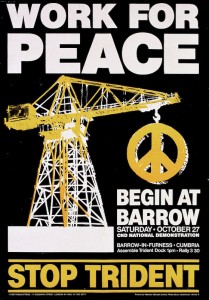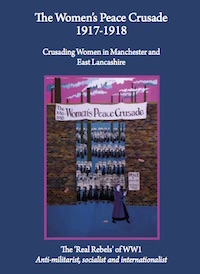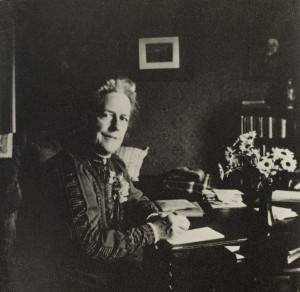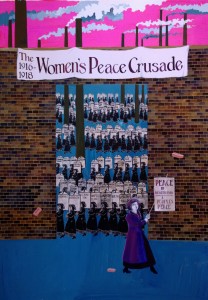There had been opposition to the First World War, both before its outbreak and during. But from 1916, and particularly after the Somme, until Armistice in 1918, a Women’s Peace Crusade movement spread across the country, including the North West, giving voice to a rising anger.
The Women’s Peace Crusade Movement in the North West: Blackpool, Carlisle, Kendal, Barrow and surrounding villages
Posted by Hilary Chuter

CND poster advertising the 1984 anti-Trident demonstration in Barrow. Image thanks to CND (http://www.cnduk.org) and Trades Union Congress Library, London Metropolitan University
On Saturday 27 October 1984 I died in Barrow. I had travelled from London alongside many other women and men to a protest called by the Campaign for Nuclear Disarmament against Trident missiles. Once there we marched together until, at a predetermined time, we ‘died’ by lying down in the streets and refusing to move. Barrow was the focus as it was where the ‘Trident Dock’ was located. (1)
This was not the first time that somewhere so closely linked with the industrial production of the weapons of war had seen anti-war protests. In the period 1916-1918 the Women’s Peace Crusade movement was active across the North West, and Barrow was one of the places where women took to the streets in protest against militarism and for peace.
On Saturday 27 October 1984 I died in Barrow.
Origins of the Women’s Peace Crusade
There had been opposition to the First World War, both before its outbreak and during. But, ‘from 1916 onwards there was an upsurge of deep anger against conscription and military tribunals; against the mounting death toll, rising food prices and lengthy queuing; and against the DORA (government Defence of the Realm rulings) attacks on personal liberties…. From summer 1917 and for the next eighteen months until Armistice, a Women’s Peace Crusade spread like wildfire across the country, giving voice to this rising anger.’ (2)
The very first large demonstration by the Women’s Peace Crusade had been held in Glasgow on 23 July 1916. This followed a series of meetings held across Edinburgh and Glasgow. (3) Speakers included Theodora Wilson Wilson who was born in Kendal in 1865, and who was one of the founders of the Fellowship of Reconciliation, a Christian group committed to absolute pacifism, in Cambridge in late December 1914. Apparently, ‘the peace-making activities of Miss Theodora Wilson-Wilson, a daughter of one of Kendal’s leading families were widely condemned. When the police raided her London flat and seized papers belonging to the Women’s Peace League, the Daily Mail reported “we have received from all quarters protests about Miss Theodora Wilson”.’ (4)
The Women’s Peace Crusade in the North West
By the summer of 1917 Women’s Peace Crusade (WPC) groups were appearing across the North West of England. In August there is reference to Blackpool. (5) In September the Directory of the WPC listed a contact for Kendal, and another for Carlisle. (6) In May 1918 it was reported that ‘new and active Peace Crusades have been started at Barrow-in-Furness, Norwich, Exeter, Rothwell and Market Harborough’. (7) In October 1918 there was a Women’s Peace Crusade meeting in Ulverston, which ‘was molested by a band of men.’ (8) All these reports came from the Labour Leader, a British socialist newspaper. (9) I have found no references in any of the local press of the time. Groups in the North West, as elsewhere, were organised by women from a variety of political, social and possibly religious backgrounds.
Blackpool
The Labour Leader, in its Women’s Peace Crusade column, reports a series of meetings held in Blackpool:
‘On Blackpool sands, Mrs Louis Anderson Fenn, (10) who is devoted to our work, speaking on Sunday for the Civil Liberties Society, and on Monday evening for the I.L.P. [Independent Labour Party], held a huge crowd for over two hours, and a Blackpool comrade, calling in at our office, described it as one of the most wonderful meetings of his life. “The people are eager for the message women like Mrs Fenn bring them,” he said. “The crowd was made up of well-paid workers and soldiers, yet she carried them all with her. The Women’s Peace Crusade is just what is wanted.” He carried off a big parcel of our leaflets for distribution.’ (11)
In October 1918 there was a Women’s Peace Crusade meeting in Ulverston, which ‘was molested by a band of men.’
Mrs McNaughton, 12 Crummock Street, Carlisle
The only reference to the existence of a Women’s Peace Crusade in Carlisle that I have found comes from the WPC Directory listing. (12) From the 1911 census I have identified Mrs McNaughten as Martha McNaughton, married to Daniel McNaughton. Daniel was a tin biscuit box maker who probably worked for Hudson Scott and Sons, James Street, Carlisle. They were tin manufacturers who made biscuit boxes for Carr’s. No profession is given for Martha but she was 37 and had three young children living at home in 1911. (13). She died, aged 66, on 10th August 1941. (14)
Mrs Braithwaite, Ghyll Close, Kendal
Ghyll Close, Kendal was built in 1868 for a local Quaker woollen merchant, Charles Lloyd Braithwaite, and his wife, Susanna Wilson. In 1911 Isaac Braithwaite, Charles’s son, inherited the property, and it is very likely that ‘Mrs Braithwaite’ is Isaac’s wife, Mary Snowden Braithwaite.
Mary Snowden Braithwaite, née Thomas, was born into a Quaker family in Baltimore in 1851. She was the sister of Dr Richard Henry Thomas, who had married Anna Braithwaite from Banbury, England in 1878. Isaac Braithwaite had been a wedding guest, and Isaac and Mary married in Baltimore in 1890. Isaac and Mary lived in Kendal and were active in the Quaker movement in the area. The Braithwaite family had been Quakers for many generations. ‘ Two noted women preachers were amongst Isaac Braithwaite’s ancestors. Rachel Wilson, who had travelled widely in Ireland and America in the third quarter of the 18th century and Anna Braithwaite, his grandmother … who also had extended service in the United States.’ (15)
The Thomas family of Baltimore also had a long Quaker history and Dr Richard Henry Thomas spent many years preaching widely in America and Europe. Mary continued her Quaker work once she was in Kendal. ‘She was a very active worker in the Society of Friends and (at the time of her marriage) was already a recorded active minister.’ (16) Richard wrote a letter to his sister in May 1893 commenting that ‘it was very pleasant to get a letter today about your meetings in Sedbergh. (17) In 1895 Richard Thomas and his wife, Anna Braithwaite Thomas, were staying with Isaac and Mary where ‘a series of meetings was now held at Kendal, and then we went to Swarthmore and had meetings … In much of this work in Westmorland our sister and brother Mary S and Isaac Braithwaite were with us.’ (18) In 1907 Mary and Isaac were asked to undertake the wardenship of Woodbrooke, ‘a Settlement for Religious and Social Study connected with the Society of Friends.’ (19)
Mary and Isaac returned to Kendal in 1914. It seems likely that Mary would have been involved in peace activities locally. There is mention of her in a list of subscribers to the Women’s International League for the year ending August 1918. (20) Her family connections also make it likely. Her sister-in-law, Anna Braithwaite Thomas, was in England during the First World War ‘where she served on the Alien’s Committee and a relief mission to Vienna, Austria, after the War.’ (21) Her niece, Dr Henrietta Martha Thomas, was involved in pacifist service in Germany and Austria before she died in 1919. So, although I have been unable to find any specific evidence of Women’s Peace Crusade activity in Kendal, other than the mention of Mrs Braithwaite, Ghyll Close, it seems very probable that Mary Snowden Braithwaite was indeed that person.
‘The committee endorsed the action of the governors of Ilkeston Secondary School in dismissing Miss Nora Hague, assistant mistress, for distributing pacifist literature.’
Miss Nora C. Hague, Barrow and surrounding villages
The Women’s Peace Crusade had been formed in Barrow in the spring of 1918. In June ‘two open air meetings were held which proved strikingly successful. Mrs Helen Crawfurd addressed huge and attentive crowds on the square and created such a deep impression that little opposition was shown. Numbers of special constables and detectives were present, whose services, however, were not required. The collections were good and new members were enrolled.’ (22) Helen Crawfurd had been instrumental in setting up the Women’s Peace Crusade in Glasgow.
The Labour Leader advertised in autumn 1918 that ‘Miss Hague will be in Barrow from September 28 till October 6. If any town near Barrow would like to have a Women’s Peace Crusade I should be glad to consider the possibility of helping to start one.’ (23) By October the Labour Leader commented:
‘Miss Nora Hague reports on her progress in the Barrow area, where she has had village meetings and has addressed gatherings of the Cooperative Guilds, Women’s Labour Leagues and the National Federation of Women Workers. At Ulverston the meeting was “molested by a band of men who prevented our getting any kind of hearing – the police ordered us out of the room we had hired, while our audience sat perfectly quiet waiting to hear us but unable to do so because of the organised band.” Miss Hague finds the women of the crusade keen and enthusiastic.’ (24)
Nora Hague was a seasoned anti-war campaigner, active in the Derby branch of the WPC. Circumstances had allowed her to take on the role of travelling organiser. In 1917 she was sacked! It was reported in the press that ‘The committee [Derbyshire Education Committee] endorsed the action of the governors of Ilkeston Secondary School in dismissing Miss Nora Hague, assistant mistress, for distributing pacifist literature. It was stated that there was nothing against her professionally and that what she did was from a high sense of religious duty. The Independent Labour Party and Ilkeston Trades Council wrote to the Committee protesting against the governors’ action.’ (25) It would appear that these appeals fell on deaf ears. In March 1918 the Labour Leader reported that ‘excellent reports are reaching us of Miss Hague’s work in the Midlands’ and she was soon the Midlands organiser. (26). By May 1918 she is described as ‘the National Organiser’! (27) In August, before she started her organising in the Barrow area, as a result of her ‘indefatigable work … several new crusades [had] been started in the villages around Leicester.’ (28) It would seem that Nora Hague single-handedly helped to organise many of the crusades up and down the country.
Lancaster
I have found no reference to any WPC activity in Lancaster. That is not to say there wasn’t any. During the course of any conflict there will be voices raised in opposition. But often these voices are not recorded, particularly in the local press, which was far more likely to be printing pro-war articles.
What happened to the Women’s Peace Crusade?
In November 1918 it was suggested in the Labour Leader that Women’s Peace Crusade groups constitute themselves as branches of the Women’s International League. This became the Women’s International League for Peace and Freedom in 1919 and still exists today as an international organisation. Many women will have continued being active in various political, social or religious groups. Some will have returned to their ordinary lives as the war ended. However, in the years following the war, there was a surge in peace activism locally, nationally and internationally and women continued to play a prominent part in this. In 1922, Lancaster held a large No More War demonstration and in 1926, 150 people joined the national Peacemakers’ Pilgrimage at Lancaster en route to London.
In Lancaster today there will be women alive whose mothers, grandmothers, great-grandmothers, aunts etc. campaigned in the North West in opposition to the First World War and who may well have come across the Women’s Peace Crusade or subsequent movements for peace.
NEW RESEARCH ON THE WOMEN’S PEACE CRUSADE IN THE NORTH WEST
Hilary’s research for Documenting Dissent has fed into another local community heritage project. ‘The Women’s Peace Crusade in Manchester and East Lancashire 1917-1918’ was funded in 2016 through ‘Voices of War and Peace,’ the First World War Engagement Centre supported by the Arts and Humanities Research Council in partnership with the Heritage Lottery Fund. Dr Ali Ronan coordinated the research, working with support from the Centre for Regional History in Manchester Metropolitan University (MMU). Over 100 people were involved in the project, making a film about the Women’s Peace Crusade and researching for a book that has recently been published by MMU. Hilary’s research on women peace activists in Cumberland and Westmorland is featured in this new book.
Ali Ronan writes this about the project:

Cover of the book, The Women’s Peace Crusade 1917-1918: Crusading Women in Manchester and East Lancashire
The Women’s Peace Crusade swept through industrial East Lancashire in the summer of 1917. It was part of a series of spontaneous women-led demonstrations across the country, mobilised by socialist and internationalist women, urging the Government to negotiate a peace.
This specific piece of research aimed to uncover the ‘ordinary’ Crusader, the local and ‘unheard’ women in the cotton spinning and weaving towns of Blackburn, Manchester, Burnley and Nelson Oldham, Rochdale and Bolton, towns where recruiting was strong. We have also had contributions from researchers in Bradford and from a volunteer working with the Documenting Dissent team in Lancaster.
The research has been led by a team of dedicated and enthusiastic volunteers working alongside archivists in local archives. The volunteers have met regularly to compare their research and findings and Ali Ronan has gone to visit each small team in their archives and to work together with the researchers.
The newly recovered stories form the basis of a film made by the Clapham Film Unit and scripted by Hazel Roy, using the local findings. The film recreated the Crusades in East Lancashire, using the fictional cycle journey of the young Manchester undergraduate and Women’s International League member, Mabel Phythian, to link up the Crusades from Manchester to Nelson. The research has also been put together in a book, The Women’s Peace Crusade 1917-1918: Crusading Women in Manchester and East Lancashire.
Many of these local stories have not been told in any detail before: the research has used material from newspapers of the time, the directory of Crusade organisers and their addresses, published in the Labour Leader in the summer of 1917: census returns, and local lists of Conscientious Objectors taken from the Cyril Pearce Register (IWM). Some of the material has changed our understanding of the Crusade locally and has revealed many previously unknown local women who were coordinating local demonstrations. These ‘ordinary’ women have truly been hidden from history.
To purchase a copy of the book, The Women’s Peace Crusade 1917-1918: Crusading Women in Manchester and East Lancashire (£5), please contact Ali Ronan: a.ronan at mmu dot co dot uk.
- Constructed between 1982 and 1986, Devonshire Dock Hall ‘was known colloquially as “Maggie’s Farm” in reference to the then Prime Minister Margaret Thatcher, who opened the facility, and whose Conservative Party government were upgrading the UK’s submarine-launched nuclear weapons from Polaris/Poseiden to the Trident system.’ (Wikipedia: Devonshire Dock Hall: https://en.wikipedia.org/wiki/Devonshire_Dock_Hall).
- Liddington, Jill, 1989. The Long Road to Greenham: Feminism and Anti-Militarism in Britain since 1820. (London: Virago Press), p.109.
- Liddington, Jill, 1989. The Long Road to Greenham: Feminism and Anti-Militarism in Britain since 1820. (London: Virago Press), p.116.
- Bingham, Roger K., 1995. Kendal: A Social History, (Milnthorpe: Cicerone Press), p.374.
- Labour Leader, 9 August 1917. Held at Working Class Movement Library, Salford.
- Labour Leader, 27 September 1917.
- Labour Leader, 8 November 1917 and 30 May 1918.
- Labour Leader, 10 October 1918.
- In 1912 the editor of the Labour Leader was Fenner Brockway, ‘who imposed a policy of strident https://en.wikipedia.org/wiki/Pacifismpacifism, opposing the First World War with front-page headlines such as “The War Must Be Stopped” and “Down With The War.” In 1915 the paper’s offices were raided by the police and Brockway was charged with publishing seditious material. Brockway won the case, but commented, “If we weren’t dangerous to the government we were failing in our duty!” (Wikipedia: Labour Leader: https://en.wikipedia.org/wiki/Labour_Leader). For more about Fenner Brockway, see articles written by other project volunteers for this website.
- Louis Anderson Fenn is listed in The Pearce Register of British WW1 Conscientious Objectors. He is described as a political organiser, a member of the No Conscription Fellowship in Liverpool, a Quaker and a member of the Independent Labour Party. He was imprisoned in Dartmoor from 11/5/1917 to 19/7/1917. I think it is safe to assume that his wife shared his politics and was as much a political organiser as he was.
- Labour Leader, 9 August 1917.
- Labour Leader, 27 September 1917.
- 1911 England census.
- Information from www.ancestry.co.uk.
- Isaac Braithwaite’s obituary, Westmorland Gazette, February 1929, p.3. Held at Kendal Library.
- Isaac Braithwaite’s obituary, Westmorland Gazette, February 1929, p.3.
- Thomas, Anna Braithwaite, 1905. Richard H. Thomas M.D., Life and Letters. (London: Headley Bros), p.286. Available at: https://archive.org/stream/richardhthomasm02thomgoog#page/n11/mode/2up
- Thomas, Anna Braithwaite, 1905. Richard H. Thomas M.D., Life and Letters. (London: Headley Bros), p.253 and p.305. Available at: https://archive.org/stream/richardhthomasm02thomgoog#page/n11/mode/2up
- Isaac Braithwaite’s obituary, Westmorland Gazette, February 1929, p.3. Woodbrooke still exists today. It describes itself as ‘Europe’s only Quaker Study Centre. It is based in the former family home of the local chocolate maker, George Cadbury, himself a Quaker, and has, since 1903, provided education for those of any faith or none from around the world’ (Woodbrooke Quaker Study Centre: https://www.woodbrooke.org.uk/pages/about-woodbrooke.html).
- The Women’s International League (WIL) was founded in 1915. Among the WIL records held at the Cumbria Archives Centre, Carlisle, there is reference as follows for subscriptions to WIL for the year ending August 1918: ‘Braithwaite, Mrs M.G. (paid £1 1s)’ and ‘Braithwaite, Mrs Snowdon (paid £20).’ Archive ref: DMAR/4/80.
- Friends Historical Library of Swarthmore College. Anna Braithwaite Thomas Family Papers, 1869-1943 [online]. Available at: http://www.swarthmore.edu/library/friends/ead/5148abth.xml
- Labour Leader, 27 June 1918.
- Labour Leader, 19 September 1918.
- Labour Leader, 10 October 1918.
- Derbyshire Courier, 22 December 1917. British Newspapers Online.
- Labour Leader, 14 March and 21 March 1918.
- Labour Leader, 16 May 1918.
- Labour Leader, 29 August 1918
Further reading:
Ronan, Alison, 2015. Unpopular Resistance: The Rebel Networks of Men and Women in Opposition to the First World War in Manchester and Salford 1914 – 1918. North West Labour History Society.
Poster 4: The Women’s Peace Crusade, 1916-1918 [online]. The World is my Country. Available at: http://theworldismycountry.info/posters/poster-4-the-womens-peace-crusade-1916-1918/



